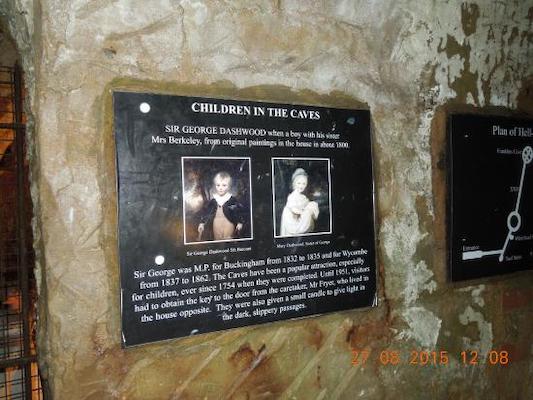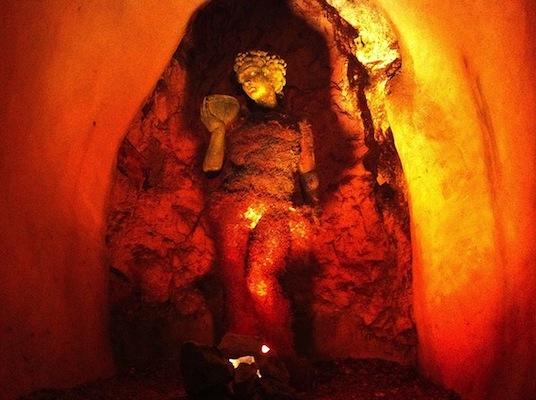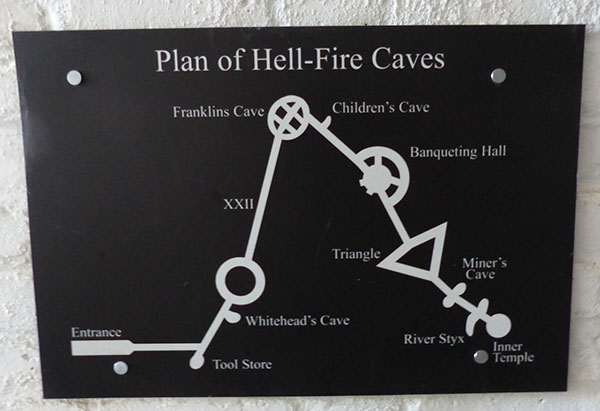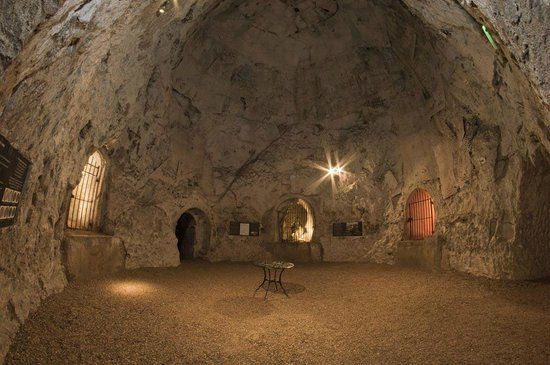In early July 1885, journalist and prominent member of British high society, William F. Stead, published a four part series in the Pall Mall Gazette entitled, The Maiden Tribute of Modern Babylon. In these articles Stead exposed a highly organised child sex trafficking industry operating tacitly throughout a network of London brothels. This industry, Stead wrote, was used to service members of the aristocracy; along with other high powered individuals within institutions - legal, religious, political, and otherwise; with little girls aged anywhere from 5-15 years. These girls were used to service a vice, seemingly cultural in its pervasiveness, which lusted to violate the chastity of virgins in an extremity of ways.
Stead was well situated to account for such things, as he himself was a member of the upper British class, and as such, these articles were somewhat of an appeal to his peergroup, to stop violently raping little girls, if not for moral decency, then for that of societal stability; citing a similar culture of vice ripe amongst the French aristocracy, which a century prior had contributed to the liberal use of the guillotine during those times of class tension. For who would show mercy, during times of class agitation, towards those who indiscriminately rape their daughters? Stead's status as a well connected civilisational scholar is evidenced by the fact he was a founding member of the Cecil Rhodes society, a group responsible for incubating the think tanks, The Royal Institute of International Affair then later the Council on Foreign Relations, used to stitch together the foreign policy of english speaking nations into a monolithic Anglo-American bloc1.
All four articles of The Maiden Tribute of Modern Babylon can be read in full here:
- The Maiden Tribute of Modern Babylon I: the Report of our Secret Commission W. T. Stead (The Pall Mall Gazette, July 6, 1885)
- The Maiden Tribute of Modern Babylon II: the Report of our Secret Commission W. T. Stead, (The Pall Mall Gazette, July 7, 1885)
- The Maiden Tribute of Modern Babylon III: the Report of our Secret Commission W. T. Stead, (The Pall Mall Gazette, July 8, 1885)
- The Maiden Tribute of Modern Babylon IV: the Report of our Secret Commission W. T. Stead, (The Pall Mall Gazette, July 10, 1885)
To illustrate succinctly the nature of what Stead's investigation exposed, the following excerpts shed some light. As it must be made clear, due to confusion that could amount from the age of consent being 12 at the time, that consent had absolutely nothing to do with it. The acts being committed were violent rapes, and at times involved the torture and/or murder of little girls and young women.
“The maw of the London Minotaur is insatiable, and none that go into the secret recesses of his lair return again. After some years' dolorous wandering in this palace of despair–for "hope of rest to solace there is none, nor e'en of milder pang," save the poisonous anodyne of drink–most of those ensnared to-night will perish, some of them in horrible torture.”
“London's lust annually uses up many thousands of women, who are literally killed and made away with–living sacrifices slain in the service of vice. That may be inevitable, and with that I have nothing to do. But I do ask that those doomed to the house of evil fame shall not be trapped into it unwillingly, and that none shall be beguiled into the chamber of death before they are of an age to read the inscription above the portal–"All hope abandon ye who enter here." If the daughters of the people must be served up as dainty morsels to minister to the passions of the rich, let them at least attain an age when they can understand the nature of the sacrifice which they are asked to make.”
“And that crime of the most ruthless and abominable description is constantly and systematically practised in London without let or hindrance, I am in a position to prove from my own personal knowledge–a knowledge purchased at a cost of which I prefer not to speak. Those crimes may be roughly classified as follows:–
I. The sale and purchase and violation of children.
II. The procuration of virgins.
III. The entrapping and ruin of women.
IV. The international slave trade in girls.
V.Atrocities, brutalities, and unnatural crimes.”-
“At this point in the inquiry, the difficulty again occurred to me how was it possible for these outrages to take place without detection. The midwife, when questioned, said there was no danger. Some of the houses had an underground room, from which no sound could be heard, and that, as a matter of fact, no one ever had been detected. The truth about the underground chambers is difficult to ascertain. Padded rooms for the purpose of stifling the cries of tortured victims of lust and brutality are familiar enough on the Continent. "In my house," said a most respectable lady, who keeps a villa in the west of London, "you can enjoy the screams of the girl with the certainty that no one else hears them but yourself."
“To oblige a wealthy customer who by riot and excess had impaired his vitality to such an extent that nothing could minister to his jaded senses but very young maidens, an eminently respectable lady undertook that whenever the girl was fourteen or fifteen years of age she should be strapped down hand and foot to the four posts of the bedstead, so that all resistance save that of unavailing screaming would be impossible. Before the strapping down was finally agreed upon the lady of the house, a stalwart woman and experienced in the trade, had volunteered her services to hold the virgin down by force while her wealthy patron effected his purpose. That was too much even for him, and the alternative of fastening with straps padded on the under side was then agreed upon. Strapping down for violation used to be a common occurrence in Hall-moon-street and in Anna Rosenberg's brothel at Liverpool. Anything can be done for money, if you only know where to take it.”
“As in the labyrinth of Crete there was a monster known as the Minotaur who devoured the maidens who were cast into the mazes of that evil place, so in London there is at least one monster who may be said to be an absolute incarnation of brutal lust. The poor maligned brute in the Cretan labyrinth but devoured his tale of seven maids and as many boys every ninth year. Here in London, moving about clad as respectably in broad cloth and fine linen as any bishop, with no foul shape or semblance of brute beast to mark him off from the rest of his fellows, is Dr,–––, now retired from his profession and free to devote his fortune and his leisure to the ruin of maids. This is the "gentleman" whose quantum of virgins from his procuresses is three per fortnight–all girls who have not previously been seduced. But his devastating passion sinks into insignificance compared with that of Mr. –––, another wealthy man, whose whole life is dedicated to the gratification of lust. During my investigations in the subterranean realm I was constantly coming across his name. This procuress was getting girls for –––, that woman was beating up maids for –––, this girl was waiting for –––, that house was a noted place of –––'s. I ran across his traces so constantly that I began to make inquiries in the upper world of this redoubtable personage. I soon obtained confirmation of the evidence I had gathered at first hand below as to the reality of the existence of this modern Minotaur, this English Tiberius, whose Caprece is in London.”
Stead, himself a scholar intimately involved in the early stages of civilisational planning for the British commonwealth; drew heavily upon mythological metaphors to infer a possible heritage, or influence, to this heinous culture of the aristocracy. The title of his investigation compared this culture to that of ancient Babylon, and throughout the body referenced heavily the Cretan myth of the Minotaur. For now, regard these as mere allusion or metaphor, but keep in mind the following:
- A labyrinth somewhere within the city of Knossos on the island of Crete.
- A Minoan(Cretan) goddess called Potnia, or “Potnia of the Labyrinth”.
- A bull within that labyrinth, or Minotaur, to which fourteen youths were sacrificed annually, or every nine years, depending on the source.
- A Babylonian Goddess of the planet Venus named Ishtar, whose consort had once been a heavenly bull torn to pieces by Gilgamesh, in the first ever epic poem of recorded history.
18th Century Rakes Clubs - The Hellfire Clubs
Perhaps what Stead was alluding to was the culmination of rake club deviance from the century prior, combined with the British scholarly fascination for the more esoteric aspects of Greek and Roman mythology, specifically, the Orphic mysteries.
The Dilettanti Society was an 18th century aristocratic social club dedicated to the study of Greek mythology. Among its alumni were those who would go on to found the Hellfire Clubs. Among these were: John Montague(Lord Sandwich), George Dodington(Baron Melcombe), Francis Duffield, Paul Whitehead, Thomas Potter, John Wilkes, and the infamous Franchis Dashwood.
The first, founded by Philip Wharton(1st Duke of Wharton), held ritualistic orgies within a Westminster mansion known as Somerset House2. Another, later founded by Franchis Dashwood, famously bore a nine chamber subterranean temple beneath a hill, atop of which a chapel-like structure was erected to serve as an entrance leading down into what are known as the Hellfire Caves.
The Hellfire clubs, while overtly satanic by many accounts3, were actually more interested, at least within the inner circles, with the neo-pagan worship of the Goddess Venus and Roman god Bacchus4.
To supply their orgies, the Hellfire clubs and others of their like, maintained close business ties with brothel owners, who began to act as their procuresses. Over time, these orgies and other such deviant activities, were moved inside the brothels themselves, as exclusive events hosted by brothel hostesses.
Of these there was Charlotte Hayes, who organised an annual child orgy for British elites called the The Feast of Venus5. Then another, Elizabeth Falkland, operated an exclusive high society brothel called The Temple of Mysteries which specialised in sadism6.
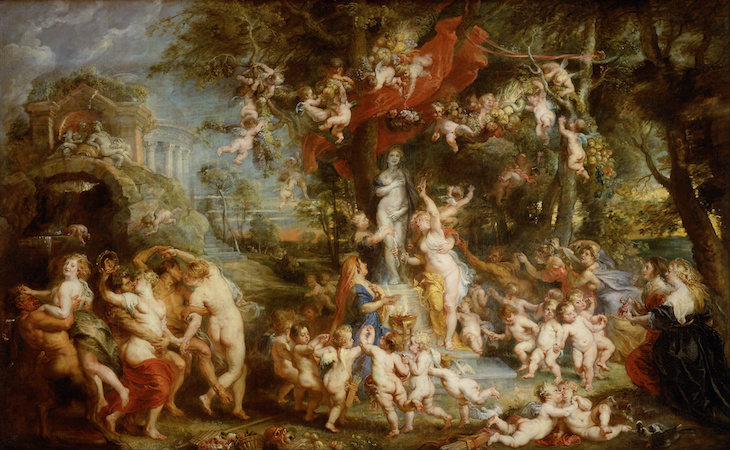
From this three things can be evidenced:
18th century Rakes clubs adopted overtly satanic rituals or practises in tacit worship, genuine or otherwise, of the Greek and Roman forms of the goddess Venus and god Bacchus.
19th century London brothels held Venus themed child orgies, and other such events, for aristocratic clientele.
William Stead compared the sexual vices of his late 19th century peers to the Minoan myth of the Minotaur and the customs of ancient Babylon.
Venus. Bacchus. The Minotaur. Babylon.
The Dilettanti Society was particularly interested in the esoteric aspects of the Greek mystery cults, which were the first secret societies of classical, and therefore western, civilisation. In 1766 it sponsored research in the subject, including an expedition. As a result, the society published the first of a five volume set called Ionian Antiquities in 1769, that detailed, among other ruins, the Temple of Bacchus in Teos7.
Bacchus was the Roman equivalent of the Greek god Dionysus, whose cult was founded according to myth by the Greek poet prophet Orpheus; who, according to the Roman poet-historian Ovid, was credited with being the first ever pederast8. It is after Orpheus the Orphic mysteries are named. The Cult of Dionysus perpetuated itself into the Roman era under the God Bacchus and festival Bacchanalia. So when we speak of Bacchus, and when we speak of Dionysus, the two are mostly synonymous. And when we speak of Dionysia, or of Bacchanalia, we speak, at least in part, of child orgies.
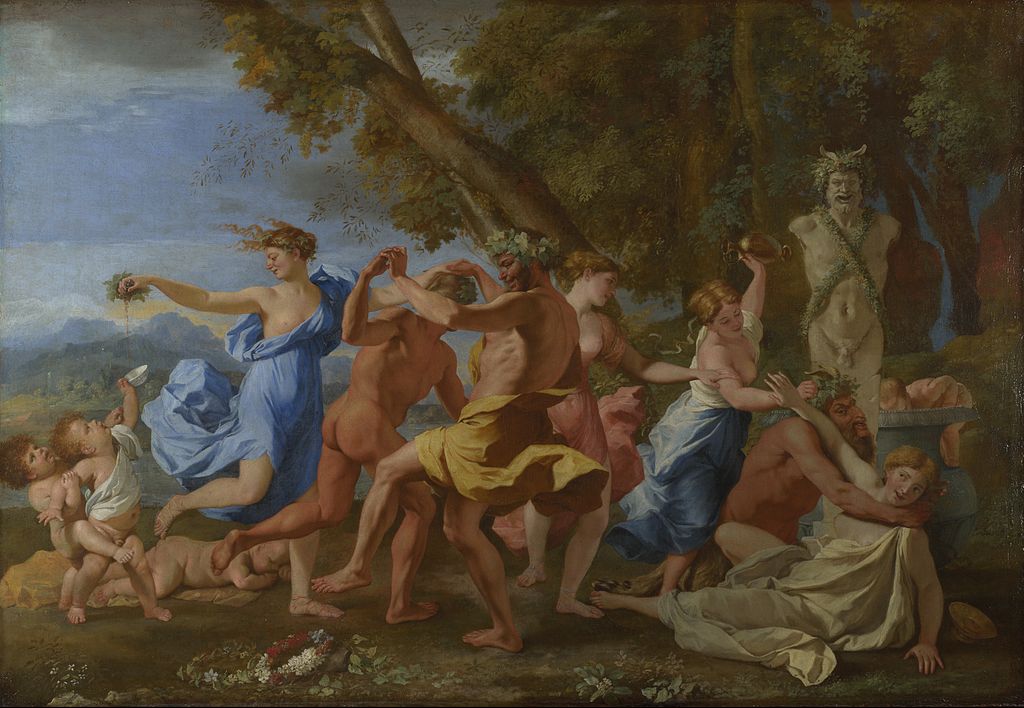
Things do get more sinister. Dionysus was worshipped by a number of different groups, but among the followers of Orpheus, a sect called the Maenads, this elusive god was worshipped in idol of a goat or bull. Worship of Dionysus in these two forms, that of a goat or bull, at times involved the ritual sacrifice and cannibalism of children. In which instances an animal was substituted for a child it remains unclear9. According to myth, Orpheus was eventually killed by these Maenads. They tore him to pieces during a possession orgy, drank his blood then ate his flesh.
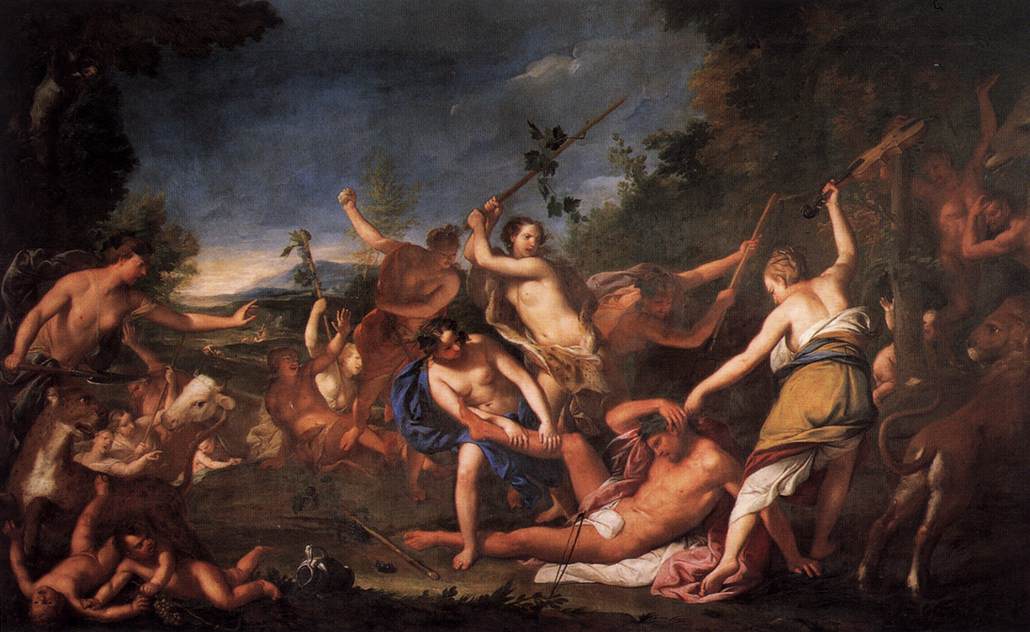
The cult of Bacchus(Dionysus) was eventually outlawed by the Roman Senate. There are theories the cult persisted underground, among those, that it integrated into the cult of Mithras, a high powered Roman Military cult whose influence on Christianity possibly explains such bizarre things as Holy communion10.
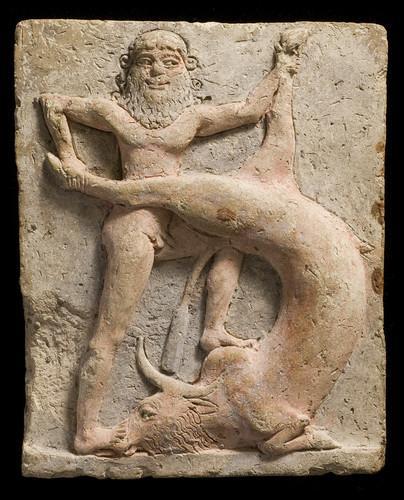
Artifact of Gilgamesh killing bull.
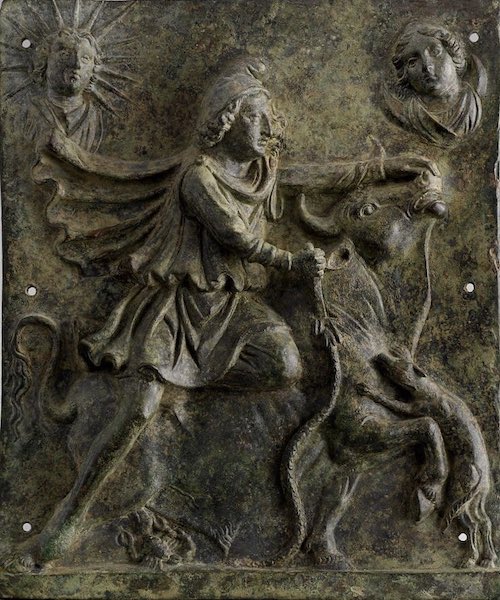
Artifact of Mithras killing bull. Statue of liberty top left corner.
It was this type of stuff, the mystery and exclusivity of ancient knowledge, 18th century aristocrats found titillating. And with a whole pantheon of gods and goddesses to idolise, it seems many fixated on Dionysus(Bacchus) and Venus. Why?
Stead's choice of the Minotaur myth as a metaphor is not pageantry often often associated with 19th century writers paid by the word. Its use has a very precise relation, to the point of giving somewhat of an explanation for, the violent sexual customs of his contemporaries.
The Minotaur myth is about a labyrinth located somewhere within the city of Knossos on the Island of Crete. Inside this labyrinth fourteen youths are sacrificed to a bull every year, or every nine years, depending on the source.
It is likely a Minoan(Cretan Civilisation) adaptation of the Sumerian epic of Gilgamesh, probably by way of the Babylonian account11. This epic poem dates back to at least 2100 BC, which precedes both Iliad and Odyssey; and is considered to be the first in the epic poem tradition. It involves a young hero, Gilgamesh, who slays a 'heavenly bull' sent to kill him by the goddess Ishtar(Babylonian name for the Sumerian goddess Innana). He tears her heavenly bull to pieces and throws them back at her.
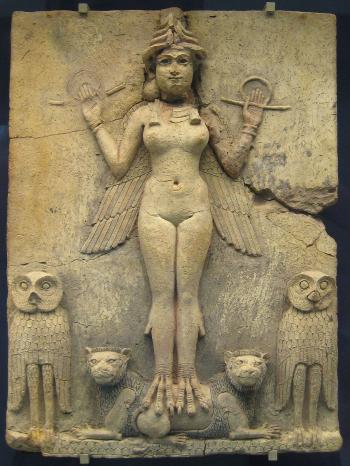
In the Minoan account, Theseus is Gilgamesh, who slays the Minotaur, a bull, possibly Moloch11. The labyrinth itself refers to the administrative buildings located in Knossos, known to have been built with many rooms, anterooms, narrow winding corridors connecting them all in maze-like architecture12.
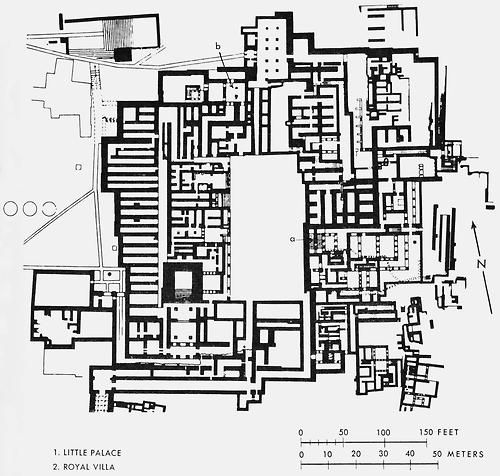
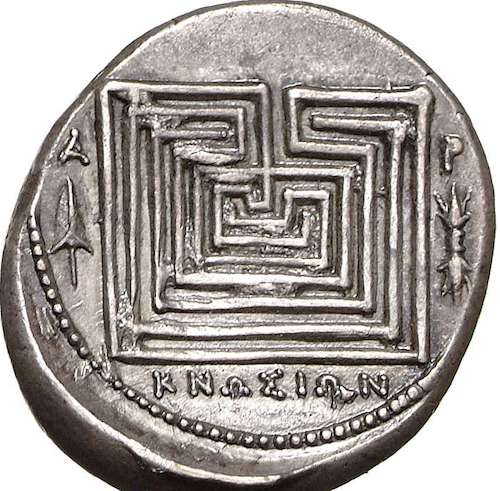
The term labyrinth derives from 'labrys', which was a double-sided axe used by Cretan priestesses for ceremonial purposes. The primary goddess worshipped in Knossos was Potnia, an earth mother goddess archetype at the top of the Minoan pantheon. A Linear B tablet discovered in Knossos associates the labyrinth with the goddess Potnia, through the line, 'Mistress of the Labyrinth’, Potnia meaning Mistress, or 'Potnia of the Labyrinth'13. Thus the Minotaur could be taken to be Potnia's bull, as it would seemingly be her labyrinth.
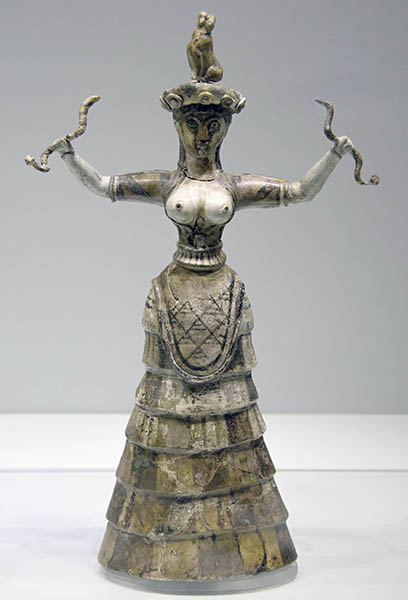
Potnia may have been the Minoan version of the Babylonian goddess of Venus, Ishtar. This is a goddess of many names and forms, but always fixed to the planet Venus. The star of Ishtar is an eight pointed star found on artefacts associated with this goddess. Some Cretan coins found in Knossos contained an eight pointed star in the center of a labyrinth design. There is more evidence for this, but the subject of the transmigration of gods and goddesses is too uncertain and digressive to be discussed at length here.

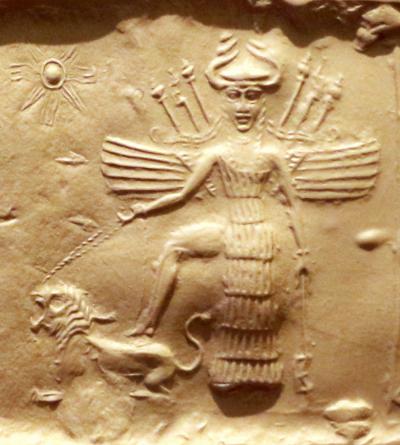
The aforementioned cult of Bacchus, emulated by the Hellfire clubs of 18th century fame, was the Roman continuation of the Greek cult of Dionysus, founded by the mystic Orpheus in worship of that god from Cretan myth, the son of Zeus, who was torn apart by the titans, eaten, and then resurrected14.
The cults of Dionysus in Crete held festivals every other year in which the death and suffering of Dionysus was reenacted in ritual. These are called the rites of Dionysus15. This ritual involved participants tearing apart a live sacrifice with their teeth and eating it, just as Dionysus had been by the titans in his origin story. The live sacrifice was often a bull or a goat, but there are accounts that human children were often times used aswell16.
The accounts of the type of sacrifice vary, not because they contradict the nature of the ritual being performed, but likely because there were different sects of this cult observing different rituals. Whenever this is the case, often times what separates them is orthodoxy. That is, the adherence to customs becoming taboo or vice versa. There appears to have been at least three distinct cults in Crete which practised Dionysian rites: A bull cult(Minotaur), a stag cult, and a goat cult17.
The Orphic sect of Dionysus worshipped him in the image of a goat. That is the Greek god Pan, which the historian poet Robert Graves contends was a Minoan adaptation of the Canaanite goat god, Baal Gad, by way of the Orphic mysteries18. Child sacrifices by the Canaanites to their various Baal's, such as Baal Hammon/Baal Moloch, is well accounted for in both historical texts and archaeological digs. One of these Canaanite Baals seemingly snuck its way into the Greek pantheon by way of Cronus, god of Saturn - probably Baal Hammon. Cronus was father to Zeus, who was father to Dionysus in the origin myth.
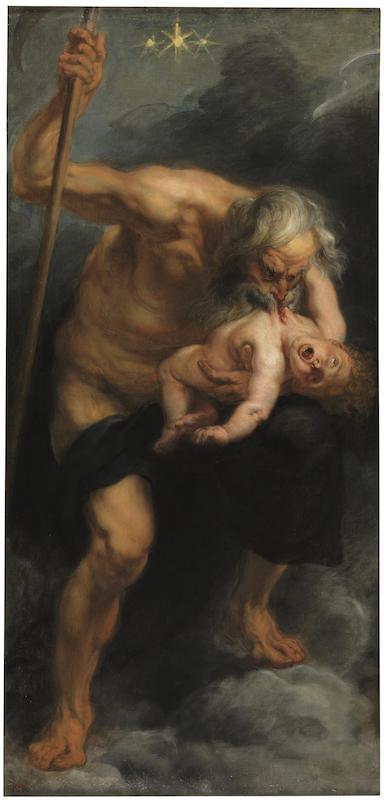
Of interest here aren't the myths themselves, but the real historical customs and rituals practised by the religious cults of Crete, particularly those of Knossos, from which these myths derive. It's important to understand that myth, poetry, among other art forms, do hold meaning of historical record keeping. And the themes contained within them can often be substantiated through archeological discoveries, as they often are, and in this case can be.
In 1979 an archaeological dig in the city of Knossos turned up a mass grave of child bones dated from the Minoan era, located not far from the Palace of Knossos('House of the Double-Axe', or. . .Labyrinth).
“In a LM IB context in excavations just to one side of the Royal Road some distance northwest of the Little Palace at Knossos, 327 children's bones were found in a burnt deposit in the basement of a building christened the North House. Originally attributed to between eight and eleven children provisionally aged between ten and fifteen years old, between 21% and 35% of these bones, which included skull fragments as well as other bones, all found in an unarticulated heap, exhibited "fine knife marks, exactly comparable to butchery marks on animal bones, resulting from the removal of meat. Cannibalism seems clearly indicated. Among possible interpretations are ritual usage (otherwise unexampled in the open town of Knossos) and lack of all other food because of poisoning or other deleterious effect of gases or fall out from intense activity of the volcano of Thera." Subsequent analysis has revealed that the bones in fact need belong to no more than four individuals, two of whom can be quite precisely aged by means of their teeth to eight and twelve years. Some phalanges (finger or toe bones) from young humans, a human vertebra with a knife cut, some marine shells, some shells of edible snails, and burnt earth were found filling a pithos in the "Cult Room Basement", a room across a corridor from the "Room of the Children's Bones" in which the cache of 327 children's bones were found. The context within the pithos suggests that some portions of young children were cooked together with a variety of other edible substances. Together with the major concentration of children's bones were also found some sheep bones including articulated vertebrae. One of the latter had a cut mark in a position indicating that the beast's throat had been slit, so that sheep sacrifice may have been connected with the death and dismemberment of the children, whom forensic experts have established to have been in perfect health at the time of their deaths. There is unfortunately no method by which these skeletons can be accurately sexed, so we remain ignorant as to whether they belonged to boys, girls, or both. Could there be some connection between these butchered children, the youths and maidens who jump bulls in Minoan representational art, and the tribute of Athenian boys and girls paid to the legendary king Minos to which Theseus, the heroic Athenian prince, put a stop with the loving help of Minos' daughter Ariadne by killing the monstrous Minotaur?”
Given the multitude of mythological evidence for the rites of Dionysus as practised in Minoan Crete, and the substantiating archaeological evidence discovered in Knossos, it is reasonable to believe that the central ritual of the Cult of Dionysus, that is, the rites of Dionysus in all its orthodoxy, was the killing and cannibalisation of children.
Given the influence of Cretan/Dionysian/Orphic myth on the customs of Victorian era aristocrats; evidenced by, among other things, the nature of their gentleman clubs and gardening habits, their penchant for hedge mazes; along with Venus themed brothels and a lust for virgins; it is reasonable to believe such customs, modified or in orthodoxy, perpetuated into the elite circles of the industrial era.
The question this series is concerned with, explored in successive parts, is whether or not these dismal customs came to take on a more political purpose in the 20th century. That of forging allegiances between those within high powered institutions through mutual participation in compromising social taboos as means for political blackmail. This practise is common throughout history when trust is scarce between those with power. The Roman senate all dug a knife into Caesar, and Stalin made every member of the politburo sign his death warrants. They scratched eachothers back with bloodied hands.
Blackmail, simply put, is the threat to expose social taboos. The greatest taboos in modern society, which can be performed at the individual level, or that of a small group, are crimes of rape, torture, and murder. The extremity of these crimes are in turn relative to the victims subjected to them. The more innocent the victim, the more extreme the crime, the greater the taboo. Since children are the most innocent and undeserving victims, it follows that the greatest taboo modern society can know, are these crimes against children. For this reason, the most potent form of political blackmail, quite literally, would be the threat to expose someone who had committed such crimes against children. And as such, may serve as an explanation to the prevalence of child rape and murder rings, exposed and subsequently covered up, time and time again in our own society, and the seemingly inexplicable ties these rings have to high powered individuals and institutions. The pillars of our society. So much so, that it almost seems as if child rape and murder has become an institution in and of itself.
| References |
|---|
1. “Stead had been introduced to the plan on 4 April 1889. . . From 1891 to 1902, it was known to only a score of persons. During this period, Rhodes was leader, and Stead was the most influential member.” - page 3, 'The Anglo-American Establishment', Carroll Quigley, Dauphin Publications 2013. |
2. “The first hell-fire club, presided over by Lord Wharton, was said by the pamphleteers who launched into the attack on this and other allied clubs, to hold indecent and blasphemous orgies at Somerset House” - page 144, 'A History of Orgies', Burgo Patridge.' |
3. “Those men who could afford it liked to add a dash of spice and sophistication to their pleasures, and as violence, bullying and rowdyism faded from their pastimes they searched for something else to take its place. They searched, and some of them found what they required in a set of neo-religious beliefs, rites and observances which could be entwined in their orgies to give them that life without which they would soon lead to tedium, morbidity and disgust. They found Satanism. |
4. "practice was rigorously pagan: Bacchus and Venus were the deities to whom they almost publicly sacrificed; and the nymphs and the hogsheads that were laid in against the festivals of this new church, sufficiently informed the neighborhood of the complexion of those hermits." Dashwood's garden at West Wycombe contained numerous statues and shrines to different gods; Daphne and Flora, Priapus and the previously mentioned Venus and Dionysus. - 'The Hell-Fire Clubs: A History of Anti-Morality', Geoffrey Ashe. |
5. “One day Charlotte Hayes sent the following invitation to her clients. 'Mrs. Hayes commends herself respectfully to Lord -----, and takes the liberty of advising him that this evening at 7 o'clock 12 beautiful nymphs, spotless virgins, will carry out the famous Feast of Venus as it is celebrated in Tahiti, under the instruction and leadership of Queen Oberea(which role will be taken by Mrs. Hayes herself).' - page 138, 'A History of Orgies', Burgo Patridge. |
6. Because she had been the mistress of a member of the aristocratic Falkland family, she adopted the name Falkland, and the three adjoining houses were known as the Fawkland Temples of Love. They were patronised by among others Lords Cornwallis, Buckingham, Loudoun, Falkland, Bolingbroke and Hamilton. The first house was the Temple of Aurora. It specialised in girls aged between twelve and sixteen (at the time the age of consent was twelve). Here elderly customers were allowed to fondle the girls but not to have sex with them, at least in theory. These little virgins were said to be 'handpicked from those brought to the establishment by their parents'. Every day they were taken walking in St James's Park, as usual to advertise their charms. From Aurora the girls could graduate to the next-door Temple of Flora, run as a luxury brothel, when they reached the age of sixteen. Finally, there was the Temple of Mysteries, which catered for those interest in flagellation and other sado-masochistic practises.” - 'Madams: Bawds and Brothel-Keepers of London', Fergus Linnane. |
7.The Royal Academy Library holds a complete copy of volumes I, II, and IV and an imperfect copy only of volume III. The first volume describes 1. the temple of Bacchus at Teos; - https://www.royalacademy.org.uk/art-artists/book/ionian-antiquities-published-by-order-of-the-society-of-dilettanti |
8.“Orpheus had abstained from the love of women, either because things ended badly for him, or because he had sworn to do so. Yet, many felt a desire to be joined with the poet, and many grieved at rejection. Indeed, he was the first of the Thracian people to transfer his affection to young boys and enjoy their brief springtime, and early flowering this side of manhood.” — Ovid. trans. A. S. Kline, Ovid: The Metamorphoses, Book X |
9.“Meantime it remains to point out that in some places, instead of an animal, a human being was torn in pieces at the rites of Dionysus. This was the custom in Chios and Tenedos; and at Potniae in Boeotia the tradition ran that it had been formerly the custom to sacrifice to the goat-smiting Dionysus a child, for whom a goat was afterwards substituted.” — Page 329 vol I. , 'The Golden Bough', James G. Frazer, (Avenel Books Edition edition of 1981. Reprint of the original two volume edition first published in 1890 by Macmillan) |
10. “What, for the early Church Councils, seemed the most diabolical and unpardonable heresy of all was the identification of the Hercules-Dionysus-Mithras bull, whose living flesh the Orphic ascetics tore and ate in their initiation ceremony, with Jesus Christ whose living flesh was symbolically torn and eaten in the Holy Communion.” — Page 116, 'The White Goddess', Robert Graves “Nonnus, the Orphic writer, explains the shift in Crete from the goat to the bull-sacrifice by saying that Zagreus, or Dionysus, was a horned infant who occupied the throne of Zeus for a day. The Titans tore him in pieces and ate him after he had raced through his changes of shape: Zeus with the goat-skin coat, Cronos making rain, as inspired youth, a lion, a horse, a horned snake, a tiger, a bull. It was as a bull that the Titans ate him. The Persian Mithras was also eaten in bull form.” — Page 183, 'The White Goddess', Robert Graves |
11. “MINOTAUR (Gr. Μινώταυρος, from Μίνως, and ταῦρος, bull), in Greek mythology, a fabulous Cretan monster with the body of a man and the head of a bull. It was supposed to be the offspring of Pasiphaë, the wife of Minos, and a snow-white bull, sent to Minos by Poseidon for sacrifice. Minos, instead of sacrificing it, spared its life, and Poseidon, as a punishment, inspired Pasiphaë with an unnatural passion for it. The monster which was born was shut up in the Labyrinth (q.v.). Now it happened that Androgeus, son of Minos, had been killed by the Athenians, who were jealous of the victories he had won at the Panathenaic festival. To avenge the death of his son, Minos demanded that seven Athenian youths and seven maidens should be sent every ninth year to be devoured by the Minotaur. When the third sacrifice came round Theseus volunteered to go, and with the help of Ariadne (q.v.) slew the Minotaur (Plutarch, Theseus, 15-19; Diod. Sic. i. 16, iv. 61; Apollodorus iii. 1, 15). Some modern mythologists regard the Minotaur as a solar personification and a Greek adaptation of the Baal-Moloch of the Phoenicians. - 1911 Encyclopædia Britannica, Volume 18 , Minotaur |
12.“The extensive maze-like arrangement of rooms is eerily suggestive of a labyrinth. (The word "Labyrinth" derives from the Minoan "labrys" meaning "double-axe", which axe symbol is also found widely at Knossos.)” - https://www.themodernantiquarian.com/site.php/10854/knossos.html#fieldnotes |
13.A Linear B tablet from Knossos listing religious offerings of jars of honey reads as follows:
KN Gg(1) 702 |
14. “Dionysus was believed to have died a violent death, but to have been brought to life again; and his sufferings, death, and resurrection were enacted in his sacred rites. The Cretan myth, as related by Firmicus, ran thus. He was said to have been the bastard son of Jupiter (Zeus), a Cretan king. Going abroad, Jupiter transferred the throne and sceptre to the child Dionysus, but, knowing that his wife Juno(Hera) cherished a jealous dislike of the child, he entrusted Dionysus to the care of guards upon whose fidelity he believed he could rely. Juno, however, bribed the guards, and amusing the child with toys and a cunningly-wrought looking-glass lured him into an ambush, where her satellites, the Titans, rushed upon him, cut him limb from limb, boiled his body with various herbs and ate it” |
15. “Turning from the myth to the ritual, we find that the Cretans celebrated a biennial festival at which the sufferings and death of Dionysus were represented in every detail." |
16. “Meantime it remains to point out that in some places, instead of an animal, a human being was torn in pieces at the rites of Dionysus. This was custom in Chios and Tenedos; and at Potniae in Boeotia the tradition ran that it had been formerly the custom to sacrifice to the goat-smiting Dionysus a child, for whom a goat was afterwards substituted.” - page 329, vol I, The Golden Bough, James G. Frazier |
17. “In Minoan Crete the bull became dominant as the Minotaur, 'Bull-Minos,' but there was also a Minelaphos, 'Stag-Minos,' who figured in the cult of the Moon-Goddess Britomart, and a Minocapros, 'Goat-Minos' cult.” |
18. “The goat-Dionysus, or Pan, was a powerful deity in Palestine. . .The Day of Atonement scape-goat was a left-handed sacrifice to him under the name of Azazel, and the source of the Jordan was a grotto sacred to him as Baal Gad, the goat king, eponymous ancestor of the tribe of Gad.” “The clue is to be found in the well-known Orphic formula: Like a kid I have fallen into milk, which was a password for initiates when they reached Hades and were challenged by the guardians of the dead. They had become one with The Kid, that is to say the immortal Dionysus, originally Cretan Zagreus or Zeus, by partaking of his flesh, and with the Goat-goddess, his mother, in whose cauldron and milk he had been seethed” |
